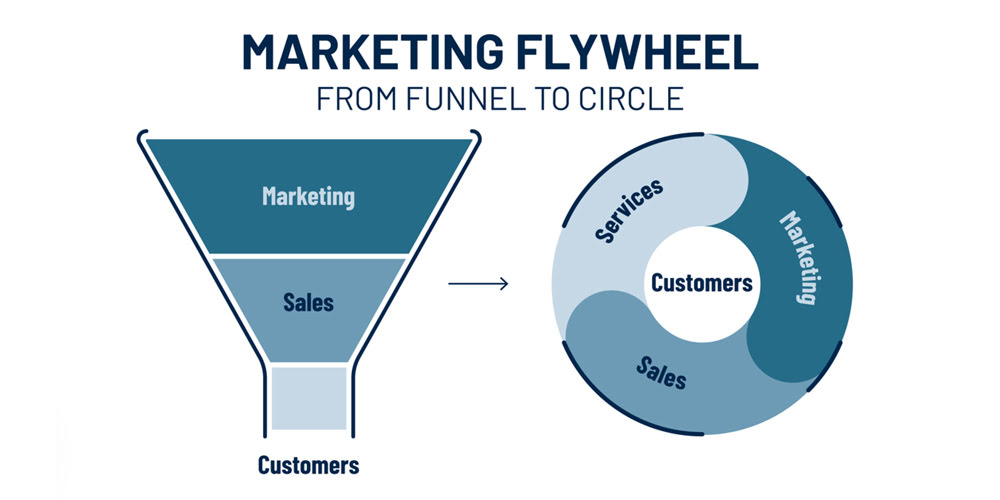
Consider a Patient Centric Marketing Model
While it has long been a go-to strategy for hospital and health system marketers, as in many industries, the traditional sales funnel has begun to fall short when it comes to achieving a top marketing goal – patient (or healthcare consumer) loyalty. To be truly successful, a health system needs to bring patients back to its providers and facilities throughout their lives, whenever they need care. As more health systems move away from the fee-for-service model of healthcare in favor of value-based care – which is more patient-centric and focused on quality over quantity – their marketing teams should follow suit.
Modern marketers across industries are turning to a more customer-centric strategy: the flywheel model. The flywheel method is a mechanism that drives consumers – in this case, patients – to a platform and keeps them coming back again and again. With the increased focus on wellness and preventive care that’s key to the value-based strategy, health systems have more opportunities to engage outside of one or two doctors’ visits each year.
With well-designed marketing strategies that personalize patient experiences, streamline care navigation, and communicate value across multiple channels, health systems can both inspire loyalty among patients and turn current patients into promoters, who then contribute to generating more leads and prospective patients. This flywheel method is a self-sustaining strategy that can fit naturally into your care model transition.
SALES FUNNEL VS. FLYWHEEL
While both the flywheel and sales funnel strategies focus on converting people from prospects into customers – or, in your case, patients – the process for each is quite different.
The traditional sales funnel is a transaction-focused, linear model. It outlines the consumer journey from awareness to interest to consideration and finally, hopefully, action. And that’s where it ends. Once a prospect has moved through the sales funnel and become a patient, there’s no dedicated pathway for retaining them and turning them into a loyal and repeat patient and advocate of your brand.
That’s where the flywheel strategy differs from the sales funnel. The flywheel puts the patient at the center at every stage, much like the value-based care model does. It helps you create a complete patient journey, identify touchpoints across that entire journey, and understand your patient’s needs and wants at each of those touchpoints. Where the sales funnel progresses only from attracting leads to engaging prospects to converting them to patients, the flywheel accelerates at the point of patient conversion to increase engagement so that patients become return customers and loyal brand ambassadors.
ADVANTAGES OF THE FLYWHEEL MODEL
As a marketing leader in your hospital or health system, your role is to champion innovation and embrace strategies that deliver value and results. The flywheel model offers a transformative approach that aligns with the needs and demands of modern patients – and provides key benefits for your healthcare institution.
- More Qualified Leads: The flywheel model focuses on delivering the best experience possible at all times throughout the patient journey. If your current patients are delighted with your health system’s providers, programs, and services, they’ll be more likely to refer their friends and family to you when they need care.
- More Team Interaction: One of the disadvantages of the funnel method is that prospects and patients interact with different departments and team members at different times in their journey. That can drive some dysfunction into the process, creating friction that decreases the chances that a new patient will become a loyal patient. For instance, while the sales team may attract a prospect, slipups by health system navigators or appointment schedulers may result in that potential patient abandoning your brand for a competitor. With the flywheel model, all team members work together across the entire patient journey, identifying pain points and prescribing solutions. As a unified team, you will be able to reduce friction and create a cohesive experience to keep the flywheel moving.
- Customer Retention and Bottom-Line Growth: Friction refers to anything that can potentially slow down your flywheel, such as inefficient internal processes, poor communication between departments, or misaligned values between your employees and patients. With less friction in the process, the flywheel allows your team to enhance patient engagement to the point where happy patients become consistent patients and ambassadors for your brand. You net more revenue over time from long-term patients who keep turning to your hospital or health system for additional care options and wellness services, and you gain more referrals for even more revenue.
CRAFTING A FLYWHEEL-FOCUSED CONTENT STRATEGY
Transitioning from the sales funnel to the flywheel model requires a shift in content strategy. Unlike the funnel, which often focuses on a patient making that one-time appointment or returning for infrequent episodes of care, the flywheel’s content strategy revolves around three interconnected stages: attract, engage, and delight.
- Attract: Create content that educates and resonates with your potential and current patients. Address their pain points, offer solutions, and establish your hospital or health system as a trusted partner that genuinely understands their needs.
- Engage: Once you’ve attracted patients, keep them engaged with valuable, relevant content. Provide resources that empower them to make informed healthcare decisions, whether it’s through educational articles, webinars, or personalized wellness advice.
- Delight: The delight stage is where the magic happens. It’s about surpassing patient expectations and consistently delivering exceptional service. Personalized communication and proactive problem-solving contribute to a memorable and satisfying patient journey.
REDUCE FRICTION IN YOUR FLYWHEEL
While the flywheel enhances the overall patient experience, it’s crucial to identify and eliminate friction points to help keep your flywheel spinning smoothly. This involves analyzing patient touchpoints, optimizing processes, and leveraging data to provide seamless interactions.
You can reduce friction by examining how your teams are structured, where prospects are getting stuck, and why some patients aren’t coming back. Here are some questions to ask yourself:
- Are your teams aligned, or are they operating in silos?
- Are your technology and appointment processes easily navigable?
- Are prospects able to connect with your hospital or health system the way they want?
By decreasing friction and increasing the speed of your flywheel, you’ll create more promoters for your hospital or health system. Those promoters will help your flywheel keep spinning, generating more leads and prospects.
WAYS TO MEASURE SUCCESS
As a healthcare marketing leader, you understand the importance of data-driven decisions. When it comes to the flywheel, metrics shift from focusing solely on conversions to measuring patient engagement, retention rates, patient lifetime value, and net promoter scores. These performance indicators reflect the flywheel’s impact on your institution’s growth and success.
By shifting from the traditional funnel to the flywheel, you’ll position your hospital or health system to drive efficiency, enhance patient experiences, and cultivate sustainable growth.
HOW TO GET STARTED
Developing a successful flywheel marketing model requires a strategic approach to attract, engage, and delight patients.
- Get your team on board: A successful flywheel requires buy-in from all team members. Communicate the shift in strategy to ensure that your marketing, sales, business development, and patient-facing departments are working together to support patients.
- Create detailed patient personas: Gather existing data on your patients to analyze their behavior and identify and understand their needs, preferences, and pain points. Regularly collect and update data to refine your personas.
- Apply Insights From Your Research: Use the information you’ve gleaned from your research to guide content creation, advertising, and targeted marketing campaigns to connect with your current patients and prospects.
At LIGHTSTREAM, we know what works for healthcare clients, and we offer a full array of branding and creative services to help your hospital or health system succeed. Connect with us today to learn more.
